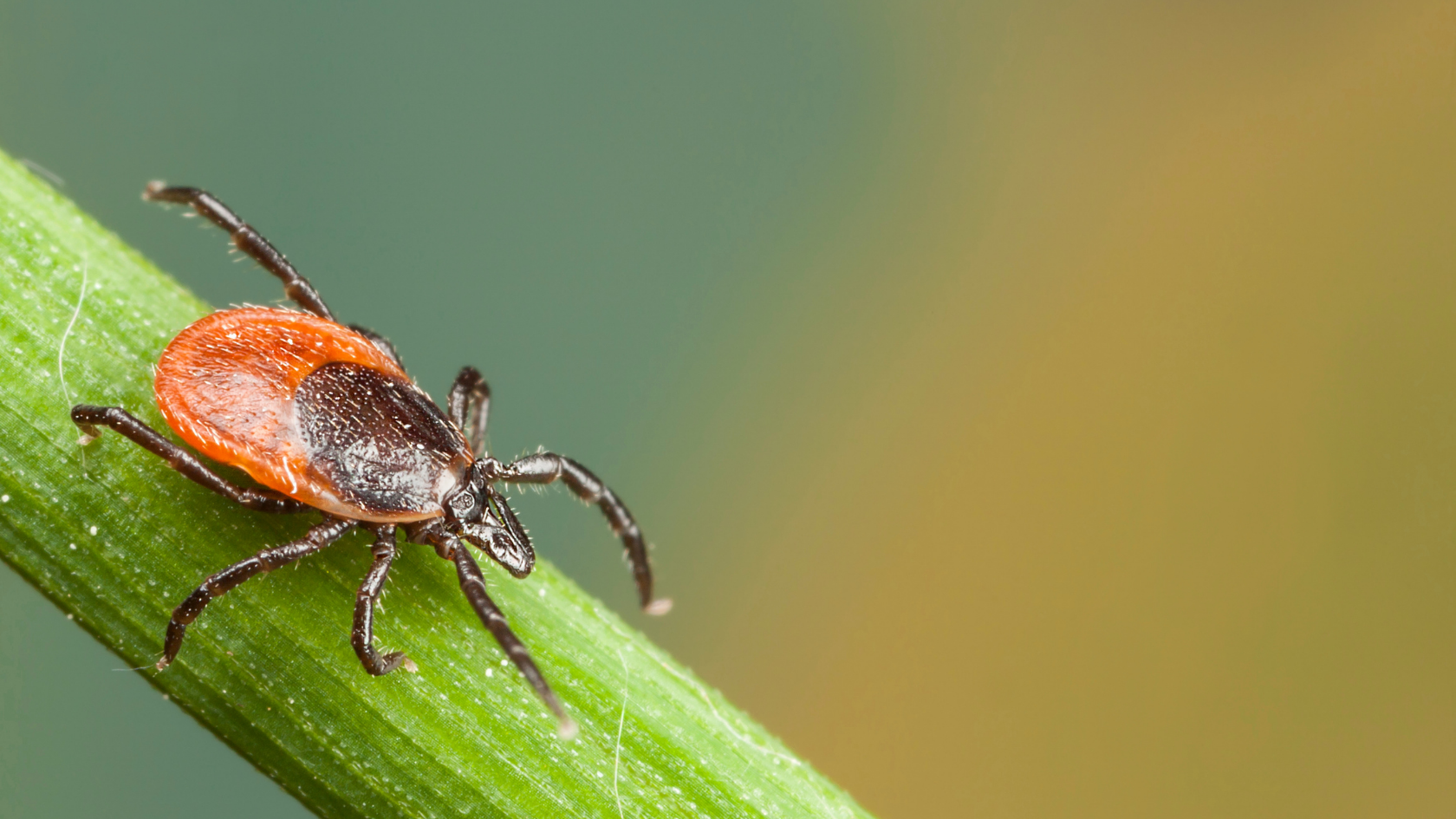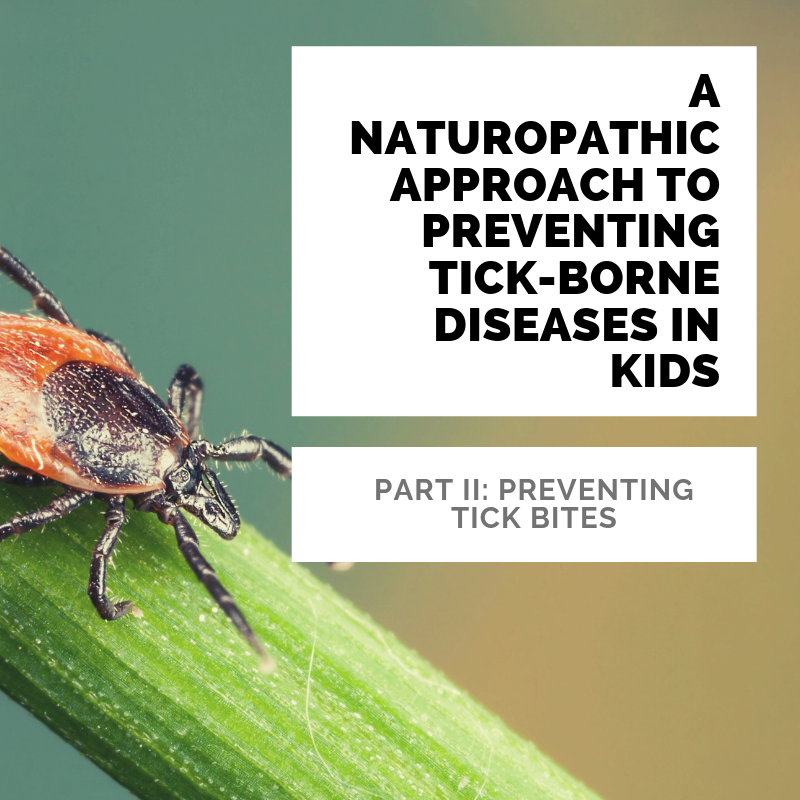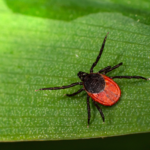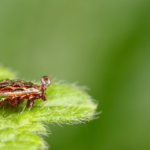
A naturopathic approach to preventing tick-borne diseases in kids. Part II – preventing tick bites.
This article is the second in a three-part series on the prevention tick-borne diseases in children and families. Part I reviews the timing of tick activity, types of ticks, diseases involved, and region where most problematic ticks are found. This article, Part II, includes information on clothing choices, yard protection and tick repellents, including natural and conventional options. Part III includes information on how to built a tick-prevention kit!
Why be concerned about outdoor time?
As we reviewed in part I, we know from research that children and adults experience significant health benefits from being outside including healthy blood pressure, improved immunity, focus, energy and sleep. However, with tick related illnesses doubling over the past decade2, we face the task of enjoying time in natural settings while minimizing tick bites and taking proactive approaches when a tick bite occurs.
Wear Protective Clothing:
Many of us are familiar with the basic guidelines for tick-bite prevention that include wearing light colored long sleeved shirts and to tuck our pants into our socks. There is specialized clothing like Rynoskin that can be worn underneath clothes, as well. Rynoskin is a lightweight chemical-free clothing material that is impenetrable to ticks, mosquitos, chiggers, and biting flies. It’s so light weight that it can be worn under clothes in the summer months and most people forget that they’re wearing them. If you spend a lot of time outdoors I would encourage you to use Rynoskin pants, socks and shirts to wear as an added layer of protection. There are also Lymeez Tick Gaitors that look like leg warmers and shin guards. They are worn over pants and socks and are constructed with a 3D mesh material that slows ticks down as they crawl up your legs. The material is treated with microcapsules of permethrin that causes ticks to die before they reach your torso. This technology minimizes tick exposure as well as your exposure to insecticides.
Protect your yard:
Keep grasses short by mowing often. Keep swing-sets and other play equipment away from the perimeter of the yard and in direct sunlight. The CDC recommends keeping a 3 foot barrier of wood chips or gravel between lawns and wooded areas to protect your backyard. Rake up leaves and other debris regularly3. Chickens and guinea hens enjoy eating ticks and are an effective way of controlling tick populations if you’ve ever been interested in having hens. Tick tubes are an EPA approved approach to keeping ticks out of your back yard and when applied correctly have a 97% efficacy rate4. They are small toilet paper sized tubes that are embedded with permethrin treated cotton. The tubes work through enticing mice to use the cotton in their nests, the permethrin in the cotton will coat the fur of mice and cause any ticks that latch on them to die. The permethrin does not affect the mice and will remain confined to the tube and mice nests, leaving your backyard chemical free.
Conventional & Natural Tick Repellants
For people who have been personally affected by Lyme disease and other tick born illnesses, conventional tick repellants may be the only option that they feel comfortable with. Conventional tick repellants are guaranteed to work, while natural tick repellants on the market have a lot of variability in effectiveness because the ingredients do not undergo the studies for safety and effectiveness that conventional ingredients undergo. The EWG’s analysis on insect repellants for adults and children and has concluded that when conventional tick repellants are applied properly they carry a low risk of toxicity and do help prevent life altering tick-borne illnesses.
Yet, some families have chemical sensitivities and may experience neurological symptoms such as headaches, irritability, difficulty focusing or brain fog when exposed to synthetic chemicals. Others may suffer from skin disorders such as eczema and hives that make it difficult to use conventional bug repellants without risking internal exposure through broken skin.
Health conscious families that decide to go the conventional route tend to use the lowest effective doses of insecticide containing sprays and they’ll confine spraying to footwear and clothes. It’s also recommended to keep bug spray off children’s hands so they don’t get insecticide in their eyes and mouth. Opting for wipes is a way of applying insect repellant without concern of inhaling chemicals from aerosolized sprays.
Picaridin is an insect repellant that many families use and it is endorsed by the EWG due to its low potential for side effects. It also lasts longer than DEET. Here is a complete safety report on picaridin. When using picaridin, a 20% solution is recommended because lower doses such as the 7% formulation are not as effective as tick repellants.
DEET is one of the oldest and most effective insect repellants but carries the potential for side effects as it can be neurotoxic at high doses, leading to rashes, dizziness, difficulty concentrating and headaches. It is also very volatile and has the ability to melt plastics, causing some families to prefer picaridin or natural alternatives. According to the EWG, children 0-6 months should avoid DEET, 6-24 months can use up to 5-10% once a day, and 12+ can use 5-10% DEET three times a day. The general public is recommended to use no more than 30% DEET.
Some families choose to spray permethrin to their clothing or to purchase clothing treated with permethrin. This reduces hassle by eliminating the need for insect repellant sprays and minimizes aerosolized inhalation of sprays.
Clinically, I see patients with chemical sensitivities exacerbate from permethrin, DEET and picaridin exposure noticing impacts in their skin, nervous, immune or endocrine systems. Natural options for tick repellants often combine insect repellant carrier oils with repellant essential oils such as lemongrass, cedar and eucalyptus. Below are a couple of brands that come highly recommended by ND’s who work with patients who live in Lyme endemic areas.
Tick Tock Naturals is an insect repellant that was designed by a chiropractor based out of New Jersey, where tick related illnesses are vey common. This product was found effective as an insect repellant in a peer reviewed study conducted by John Hopkins University and Harvard Medical School.
Pest Defy by Eden’s Garden is another essential oil blend of citronella, cedar, lemongrass and geranium and is meant to be mixed with alcohol and applied topically.
Finally, Redicare is a product that contains a mixture of neem and karanja oil, which are known for their repellant and anti-parasitic properties along with insect repelling essential oils.
If you have a child under 6 months, I would recommend using mosquito netting to help prevent bites, since their detoxification pathways and neurological systems are still developing, making it essential to reduce exposure to excessive natural or synthetic chemicals.
Opting for natural insect repellants does require experimentation with different brands to see what would work best.
Before you get into the car:
Years ago, I worked for the Department of Natural Resources tracking bird populations in Maryland. One trick that we would use after exposure to tick infested areas was to use duct tape or lint rollers on our pant legs and shirts to remove ticks from our clothing before getting into the car. It is amazing how many ticks I would remove this way and I would cringe imagining those ticks hanging in my car waiting for their next victim.
As soon as you’re home:
Remove clothing and throw them in the dryer for 10 minutes on high heat. If the clothes are wet, dry them and then add an additional 10 minutes to destroy any ticks on clothing. I usually put a load of dirty laundry in the washing machine before spending time outdoors with the family so we can do a full load of laundry when we get home. Take a bath and do a tick check as soon as you can, concentrating on the torso, head, neck and hairy areas.
 Resources:
Resources:
Faber Taylor, Andrea, and Frances E. Kuo. “Children with attention deficits concentrate better after walk in the park.” Journal of attention disorders 12.5 (2009): 402-409.
Vital Signs: Trends in Reported Vectorborne Disease Cases — United States and Territories, 2004–2016
PREVENTING TICKS IN THE YARD | TICKS | CDC https://www.cdc.gov/. (2019). Preventing ticks in the yard | Ticks | CDC. [online] Available at: https://www.cdc.gov/ticks/avoid/in_the_yard.html [Accessed 15 May 2019].
Eisen, L., & Dolan, M. C. (2016). Evidence for personal protective measures to reduce human contact with blacklegged ticks and for environmentally based control methods to suppress host-seeking blacklegged ticks and reduce infection with Lyme disease spirochetes in tick vectors and rodent reservoirs. Journal of medical entomology, 53(5), 1063-1092.


